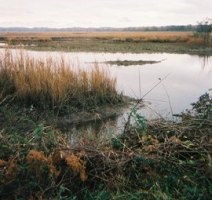
Riparian Communities It’s easy to think of any undeveloped land as natural. A golf course, for example, has green grass and trees; so do manicured lawns and leafy backyards. Both make for pretty pictures, but are they welcoming to nature? In natural systems, all things living in a common environment interact with one another and the physical world around them. Their effect on one another is what makes one place on Earth different from another. Looking at the Gorge, we see nature as a network of natural systems in constant interaction. Plant and animal species interact to create “natural communities” that are special. Some are so distinctive they are globally rare, meaning they are found in few places throughout the entire world. Not surprisingly, rare natural communities sometimes support unique, or endemic, species of animals and plants found nowhere else in the world. The Potomac Gorge is such a place. The National Park Service and The Nature Conservancy say the Gorge has more than 134 rare species and natural communities. The forests and wetlands we see are only the most obvious systems. But beneath the ground are other systems beyond our everyday observation. The Potomac groundwater amphipod lives underground in seeps and springs. Its name tells us it is found almost nowhere else on Earth. Rare and unique natural systems, above and below ground, make the Potomac Gorge what it is. The plants and animals we cherish depend on the health of these complex systems. If the systems break down, the Gorge as we know it will change over time. For example, the white-tailed deer, that endearing woodland creature, has no natural predators to keep their population in balance. When more and more deer compete for food, they eat too many tree seedlings. Over time, fewer trees grow to maturity. In a few decades, the forests of the Potomac Gorge could look very different because fewer hardwood trees will grow to replace the ones we see today. The entire character of the Gorge’s forest is being reshaped by one animal species. That type of threat is all too common in the Gorge’s many small, delicate systems. Take some time to learn about the natural systems in the Gorge. You don’t need to become an expert to appreciate and help preserve nature’s delicate balance here. As visitors to the Gorge, we can all be more mindful of our surroundings. We also can begin to nurture natural systems in our neighborhoods. When you think of it, biodiversity in the Potomac Gorge depends in part on how we treat nature in our own backyards, and how we consider it when constructing roads and buildings. Links to Learn More |
Last updated: April 10, 2015
